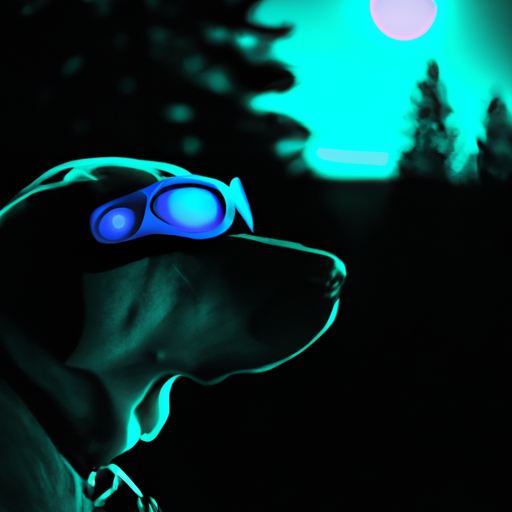Understanding Your Dog’s Vision
First, let’s get to know your canine friend’s eyesight a little better. While you might think your dog sees the world in black and white, that’s a myth. In fact, dogs see more like a colorblind human. They can see shades of blue and yellow, but have trouble distinguishing red from green.
Here’s a simple comparison table for you:
| Human Vision | Dog Vision |
|---|---|
| Full-color spectrum | Blues and yellows |
| Trouble seeing at night | Superior night vision |
| Narrower field of view | Wider field of view |
How Dogs’ Eyes Adapt to Darkness
So, how do dogs see at night? It’s all about the adaptations in their eyes. Dogs have a larger pupil than humans, allowing more light to enter the eye. Additionally, they have a higher concentration of rod cells in their eyes, which are responsible for detecting light and dark changes, shapes, and movement.
Dogs also have something called a tapetum lucidum. It’s a layer of cells that acts like a mirror, reflecting light back through the retina. This increases the light available to the photoreceptors and improves their ability to see in the dark.
Comparing Dogs’ Night Vision to Humans’
Now, how does this compare to human night vision? Well, dogs can see in light that’s five times dimmer than what we can see. Imagine the difference between a clear, moonlit night and a pitch-black room. That’s how much better your dog can see in the dark!
Improving Your Dog’s Night Vision Experience
- Keep their eyes healthy: Regular check-ups with the vet will help catch any potential issues early.
- Provide a balanced diet: Good nutrition is essential for eye health.
- Avoid sudden changes in light: It takes time for your dog’s eyes to adjust between light and dark.
- Use night lights: Soft, ambient lighting can help dogs navigate around the house at night.
How to Tell if Your Dog is Having Trouble Seeing at Night
If you notice your dog is reluctant to go out at night, frequently bumps into things, or has a cloudiness in their eyes, it might indicate their night vision is deteriorating. These signs warrant a visit to the vet to ensure there are no underlying health issues.
Frequently Asked Questions (FAQs)
Q: Can all breeds of dogs see in the dark?
A: Yes, but some breeds have better night vision than others due to their ancestral history and adaptations.
Q: What colors can dogs see?
A: Dogs can see shades of blue and yellow, but can’t differentiate red from green.
Q: Can dogs see in total darkness?
A: No, dogs need at least some light to see. However, their vision is significantly better than ours in low-light conditions.
Q: How can I improve my dog’s night vision?
A: Regular vet check-ups, a balanced diet, avoiding sudden light changes, and using night lights can all help improve your dog’s night vision.
Remember, understanding your dog’s vision will help you make their world more comfortable and enjoyable. And that’s what being a caregiver is all about, isn’t it?



